Should the Canucks Be Worried About Evan Bouchard’s Skating?

By Harman Dayal
5 years agoEvan Bouchard has one of the most impressive statistical profiles of any 2018 draft-eligible defencemen not named Rasmus Dahlin.
Bouchard outpaced all OHL defencemen — regardless of age — when it came to points(87), assists(62), shots(297), and primary points per game(0.9). Narrow down the criteria to sort by U19 defencemen historically and Bouchard’s production looks all the more impressive.

Ryan Ellis is the only defenceman since Bouchard’s birth to score more than 87 points in the OHL as an 18-year-old. It’s impressive company for Bouchard to be a part of when you consider some of the names in that cohort — a group that includes Drew Doughty, Dougie Hamilton and John Carlson in addition to Ellis.
But it’s been another defenceman in University of Michigan defenceman Quinn Hughes who’s separated himself from the pack as the premier option among second-tier blueliners in the upcoming draft. Coincidentally, it’s Hughes’ biggest strength in his sublime skating ability that also happens to be the Achille’s heel of Bouchard’s game.
Or so we’re told.
Industry opinion remains divided on Bouchard’s skating and the extent of its possible hindrance at the NHL level. A deeper analysis of game footage can shed light on the strengths and weaknesses in the way Bouchard gets around the ice.
Poor Acceleration, Good Top End Speed
For all that’s been made about Bouchard’s gaudy statistical production, not nearly enough questions are being asked about how he accrued those points. At even-strength, he was able to create offence by playing an active role in transition — both when it came to carrying the puck through the neutral zone or joining the rush as the second or third option.
Watching Bouchard play, it’s fair to question whether he can contribute in that same capacity at the NHL level.

What sticks out to me in this clip is the lack of explosiveness in Bouchard’s first few strides. He picks up speed once he crosses the top of the circle, but he’s unable to create initial separation from the Petes forechecker.
Bouchard is cognisant of his poor acceleration and often carries the puck into safer lanes, though this introduced problems of its own.
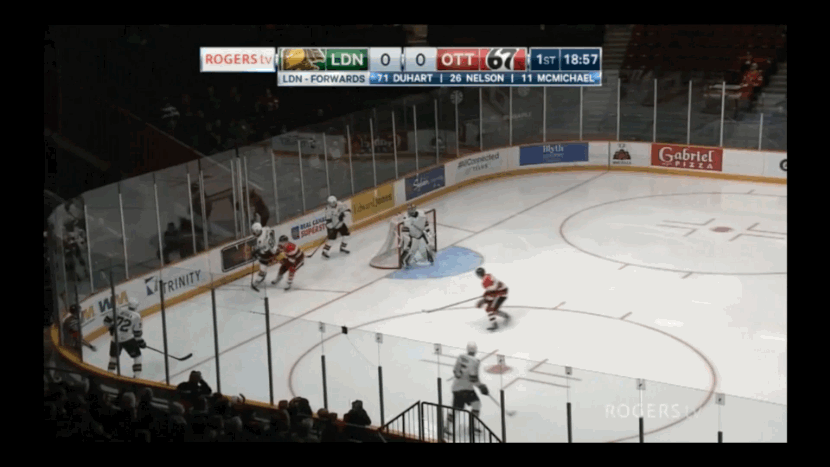
The primary issue in this play isn’t the turnover, but rather the position Bouchard has to put himself in because of his limited two-step quickness.
As Bouchard collects the puck behind the net, he’s mindful of 67’s forward Kody Clark shifting across the ice to provide support for his backchecking teammate. Bouchard knows that he can’t outpace Clark through the middle of the ice, so he’s forced to the outside lane. With the boards on his left and the 67’s pressuring him from the other side, the Knights defenceman runs out of real estate and is goaded into forcing a pass that results in a turnover.
Sure, the dispossession could have been prevented by chipping the puck out off the boards, but Bouchard isn’t put into that situation in the first place if he’s quicker with his first two steps. It’s a problem that will only be magnified in a league that features tenacious and speedy forechecking teams.
For all of the faults in Bouchard’s explosiveness, he’s able to use long and powerful strides that allow him to pick up steam when given time and space.
Bouchard flashes good top-end speed for a player of his size, but he’ll struggle to find the room to move his legs with the puck at the NHL level.
The first clip in that video is a perfect example of that.
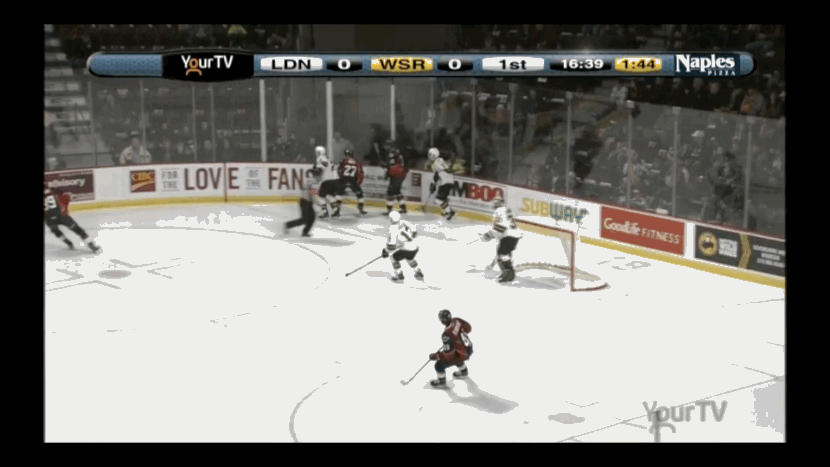
Here, Bouchard is able to exit the defensive zone cleanly because of the painfully slow skating of 6-foot-8 forward Curtis Douglas at the half-wall. Almost any other forward would have been able to move a step quicker to close the space and force Bouchard into an outlet pass to Knights’ forward Tyler Rollo.
This hypothetical wouldn’t have stopped the counter-attack, though it would have taken Bouchard out of the odd man rush.
Slow Turns and Soft Edge Work
As you move onto Bouchard’s skating away from the puck, the issues become increasingly glaring.

This clip highlights multiple deficiencies in Bouchard’s skating. He doesn’t do himself any favours right off the bat by slowing his feet when the Firebirds’ forward takes the outside lane. Bouchard then compounds the issue with a dreadfully slow turn that gives the forward the separation he needs to drive to the net uncontested.
Most concerning about this play is that the Firebirds’ forward isn’t skating into the zone at a particularly quick pace in the first place. It’s frightening to imagine the same sort of sequence in the pro ranks against a player with decent wheels.
Bouchard’s overall ability to defend the rush was routinely exploited at the OHL level, with The Athletic’s Mitch Brown’s microdata showing the Oakville, Ontario native to be decisively inferior relative to other junior defencemen.

Watching the Knights play does introduce a contextual factor that no doubt skews the data to an extent. London often employed a passive neutral zone trap with two or three forwards plugging the neutral zone while the team’s defenders sat back in the defensive zone.
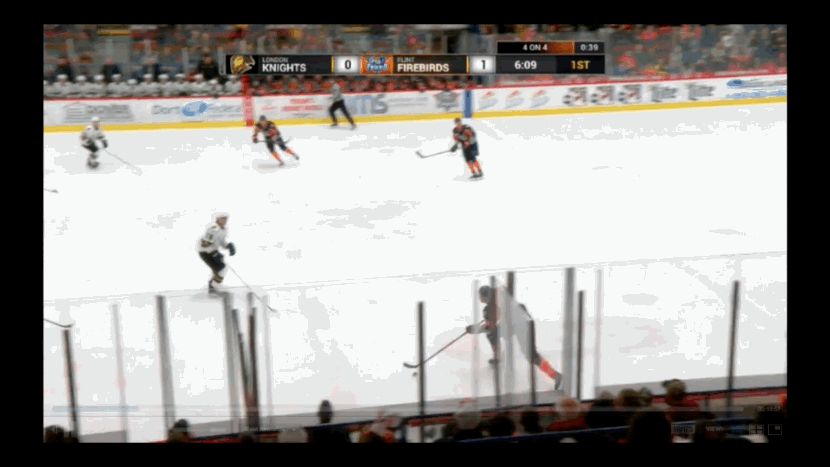
Having said that, plays like the above also highlight Bouchard’s tendency to remain passive on the puck carrier when there was a breakdown in the system. In this situation, Bouchard should have been proactive and begun closing the gap on the attacker at around the red line, when he realized that his teammate would be late in cutting off the left wing lane.
Also lacking in this play is the proper lateral movement to keep the puck carrier in front of him. Bouchard doesn’t have an explosive east-west stride while skating backwards and has to default to turning around and chasing the play in the clip. The overall outcome is passable since he does an acceptable job of keeping the attacker to the outside, but he could have done much better by playing a tighter gap and staying in front of the forward’s path for as long as possible. Unfortunately, Bouchard’s substandard acceleration and edge work limit his effectiveness in both those suggested areas of improvement.
It especially hurts him when it comes to holding a tight gap in the neutral zone.
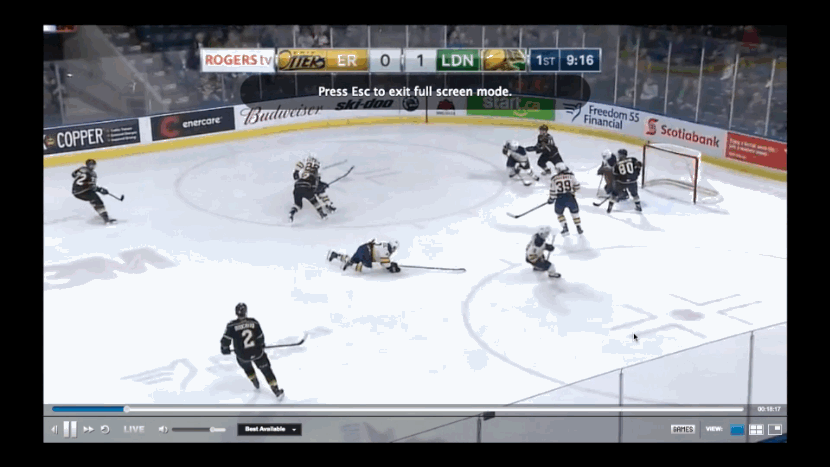
In this situation, Bouchard doesn’t even try to take time and space away from Otter’s forward Kyle Maksimovich. As a result, Maksimovich has oodles of time to survey the developing play and thread a pass across the ice for a high danger scoring chance. You’d like Bouchard to play a more aggressive gap to take that time away, but he can’t run the risk of playing the wrong angle and getting burned for speed.
Where Bouchard’s lack of deftness really gets exposed is in tight spaces.
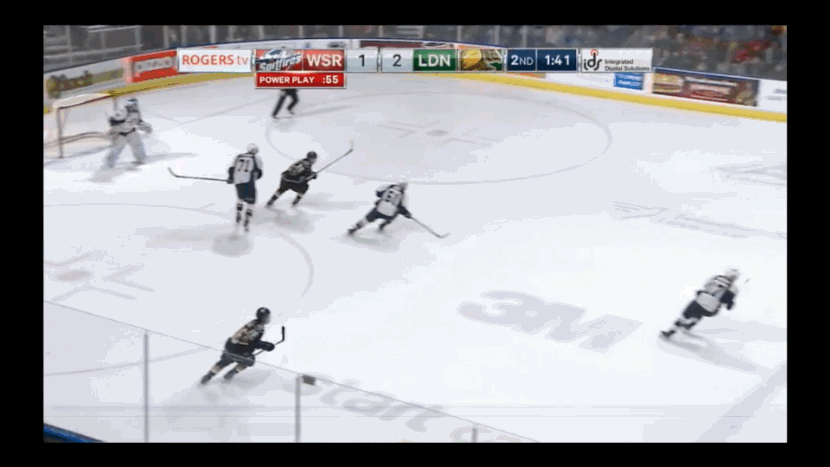
In this clip, Bouchard fakes the dump-in to try and create a moment’s hesitation to allow him the time to turn and hang on to the puck. It’s a smart idea, but Bouchard’s execution is abysmal as he glides into the turn as opposed to making a sharp pivot to steer the puck into space. He’s checked by the Spitfire’s forward and loses the puck.
Flat Feet In the Defensive Zone
The biggest issue with Bouchard’s skating isn’t a mechanical fault, but rather his tendency to drift around the ice flat-footed. The effect of this was felt in no greater magnitude than in the defensive zone, where his stagnant feet led to lackadaisical coverage.
Bouchard’s reluctance to move his feet with purpose costs him when it comes to later taking time and space away from the opposition. Casual effort away from the puck appears to be the root cause of these coverage lapses, and while it’s certainly a problem, it’s not the only debilitating factor at play.
In all of these clips, Bouchard doesn’t bother trying to take space away because he knows he doesn’t have the edgework or explosiveness in his first stride to recover in time. He needs to compensate for this by being more proactive and mobile with his feet, but instead, he remains stagnant for far too long. Look no further than the first clip from that video for a perfect example.

Colts’ forward Andrei Svechnikov almost reached the trapezoid marking by the time Bouchard decided to stop drifting away from the net. For Bouchard to have blocked the lane to the net, he needed to get his feet moving and pivot back as soon as Svechnikov made the move to pull the puck to his forehand.
Decent Backwards Skating
While some of the previous clips exposed Bouchard’s flawed turns and edgework, he actually does a good job of defending the rush when he’s able to keep the attacker in front of him. This is because he’s a good skater going backwards in a straight line — it only falls apart when the opposing forward has space and forces Bouchard to turn around.
The key in the clips above is the tight gap that Bouchard is able to play. As mentioned earlier though, he can only afford to hold it when he’s absolutely certain he has all space and angles cut off. If Bouchard is even half a step late in taking space away or if he leaves an open angle, he knows he doesn’t have the skating ability to make an adjustment and recover.
Conclusion
While Evan Bouchard has decent speed going both forwards and backward, he struggles with his turns, edges and acceleration. Unfortunately, the flaws in his skating were magnified on a regular basis due to his propensity to float around and remain flat-footed.
This will undoubtedly hamper Bouchard’s effectiveness in some facets of the game once he graduates into the pro ranks. For starters, he won’t be as effective as a puck rushing defenceman compared to junior due to his inability to create separation with his first few strides.
Without the puck, expect Bouchard to improve his coverage and gap in the own zone as he learns to become more proactive with his feet. Neither area looks to be a strength for Bouchard moving forward, but I certainly expect him to show better in both those regards than he did in junior.
Neutral zone defence, on the other hand, will likely remain a mixed bag at the NHL level. Bouchard performs adequately when he holds a tight gap and keeps the puck carrier in front of him, but both will be difficult to manage against the quicker forwards in the league. Unless there’s drastic development in the pace of Bouchard’s turns and the explosiveness of his edgework, he’ll have his fair share of problems defending against speed on the rush.
All in all, there’s definitely cause for concern with Bouchard’s skating and how it might affect the translation of his skills against bigger and faster competition. Bouchard remains a fantastic prospect given his consummate offensive toolkit, but whether he makes sense for the Canucks as their top choice at seventh overall is an entirely different debate.
Recent articles from Harman Dayal





